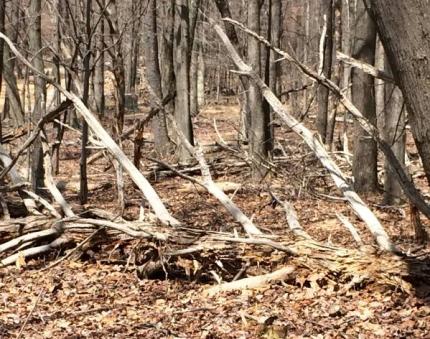
It's Easter, just after the spring equinox: the season of emergent life, resurrection, and creativity, of the coming of the light and the primal fire--and the forest near our house is full of long-fallen pine trees. The gray trunks and limbs, all helter-skelter amid brambles and vines and mounds of decaying, brown leaves, resemble skeletons in a ghostly battlefield. Scot explained once that pines are pioneer trees, the first to take root and grow in poor soil and relentless sun.
As the forest matures and fills out, other trees eventually overtake the pines, which die away, as available sunlight and nutrients are readily consumed by the larger and sturdier young oaks, poplars, and other hardwoods. Go among these twisted wood corpses and one is reminded, even in this Easter season, that death is death and loss is loss, no matter how many mosses and worms might make their livelihoods in the remains.
I have been noticing how the element air, and its hitchhiker, Sound, flows in and among the fallen and living trees, over rocks, and around the corners of our cabins, swirling around our at-last hatless heads, and dancing in the branches. The trees sing a tune, all high-pitched notes and creaking melody. The chains of cascading cds hung over the edge of the Retreat House roof to deter woodpeckers jangle and chime. Even the fire lit in the Meditation Shelter woodstove against the early spring chill hums a low cadence as it sucks in the air and pours out warmth and light. Sometimes the air roars like a locomotive surging over the forest and the top of the ridge.
Air is the invisible element in which many of the beings of this planet live. It is made up of our collective reciprocities, a cloak of giving and receiving, that sustains all who move within it. It fills the threshold between the visible and invisible, receiving and holding far more than the gases that make it up. John O'Donohue noted that not so long ago in Ireland, every field, every clearing and bend of a brook had its own name and story. With all those characters and stories swirling around, it is no wonder that there was also an ancient sense of the nearness of the invisible world. "The air is not empty," John writes, "Who knows who is here?"
If air holds stories, it also holds memories, for memories are the mind's way of preserving our stories from long ago. Memories weave a tenacious bond between one being and another. Many years ago, I lived with others in an intentional, and intense, community in the city. Our friend Dana lived there too, sharing our ups and downs, an experience both singular and transformative. In the course of things, our ways diverged: Dana married a Brit and moved to England. Years passed, and then we heard that she had cancer; was putting up a brave and difficult fight.
Then, Leslie, who also lives in Great Britain and, like Dana, had been for a time with us in that crucible of community, posted a message to us that said, in part: "I find myself thinking of you all tonight. I think it is time to hold Dana close. She talks of it being hard. She is the only person over here where I can say any of your names and we are in a similar world."
The world Leslie is referencing is the world of memory, in which a name can pull back the curtain on a host of stories that instantly flow and swirl around between and among us, reviving the broad and complex canvas of shared experience. These memories travel on currents of air across oceans and continents, indelibly connecting minds and hearts.
It seems to me that this season of spring, so celebrated for its buds and births, is just as much about tenacity and love. The broken pines and brown leaves remind us that loss and decay and letting go and drawing close are part of every season. It's the air, with its storied fullness and its music and its memories that reminds us that we are elementally connected to one another and to all beings in a great web of reciprocity and love that though invisible, is as near and as integral as breath. That's enough for Easter. That's enough.